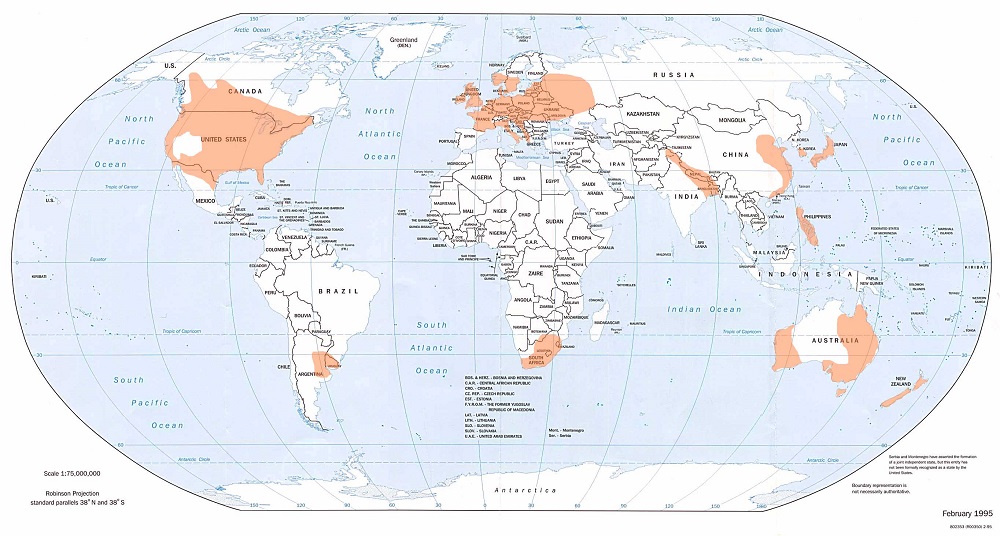
The United States experiences approximately 75 percent of the world’s known tornadoes and thus is notorious for its tornado climatology in terms of frequency, intensity, and destructive outbreak events. While it is appropriate to focus on tornadoes across the United States, it is important to recognize that tornadoes also happen in other countries of the world.
This article investigates where many of the other 25 percent of the world’s tornadoes occur, with a specific emphasis on our North American neighbors of Canada and Mexico. How do other countries match up against the United States when it comes to tornado climatology? You’re about to find out. (Hint: The U.S. is the uncontested heavy weight champion of the world.)
…North America…
Canada
This may serve as a bit of a surprise, but Canada is actually number two behind the United States for total annual frequency of tornadoes, with a whopping 5 percent of the globe’s total! While not intuitive at first, given Canada is often associated with a cold and rural landscape, it actually experiences a fairly robust tornado season from middle to late summer — typically mid-June through the month of July and into August.
If you’re familiar with the monthly tornado climatology of the United States, you can recognize that tornadoes are focused in the South during the winter, near the Gulf of Mexico’s warmth, then travel northward as the warm season arrives. Tornado activity often reaches peak in the central plains of Oklahoma and Kansas by late May and early June, eventually reaching the Dakotas by mid-June into July.
While we tend to dismiss what happens after that here in the United States, that northward trend in tornado occurrence continues into southern Canada through late summer. The Canadian Plains and Prairies, particularly encompassing the southern areas of Alberta, Saskatchewan and Manitoba, are much like the U.S. Great Plains, with flat and open terrain prone to clashes of Gulf of Mexico air and colder arctic air. Ontario and Quebec is another active tornado region in the country.
On average, Canada experiences approximately 60 to 100 confirmed* tornadoes a year, with the majority in the F/EF0-F/EF2 range. (*Disclaimer: some tornadoes likely go unreported since the majority occur over the vast and unpopulated areas of the Canadian open Prairies.)
An interesting note is that the tornado fatality rate tends to be lower in Canada than in the United States. An obvious reason for this is that lower population centers are in the path of most tornadoes, but another reason is that houses are often built stronger in order to endure the extreme winter weather conditions. Canada also tends to see fewer of the most extreme tornadoes, though the equivalent to an F5/EF5 event has been recorded there.
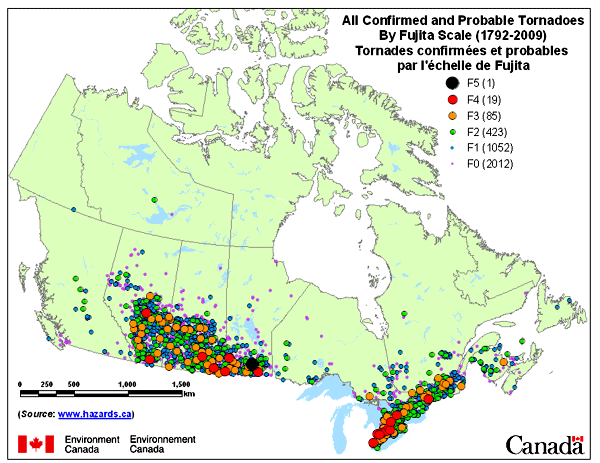
Mexico
Unlike Canada, the U.S. neighbor to the south does not have as impressive of a tornado history. Dominated by a moist and tropical air mass near the coasts and an arid one inland, Mexico is simply at too far of southern latitude for cold intrusions from the north that cause the temperature clash needed to produce numerous tornadic thunderstorms. With paltry reports of confirmed tornadoes and really no fatality records, there is not much of a tornado climatology for the country of Mexico.
One interesting fact, however, is that Mexico claims the first tornado ever reported for North America, called the “Tenochtitlan-Tlatelolco tornado” which occurred on August 13, 1521. It is likely that places just south of the border of far south Texas have a similar tornado climatology to that region, but even the U.S. side does not see as frequent activity as spots further north in the state. Tropical systems are also likely a cause of some tornadoes in Mexico.
When it comes to the continents, North America is the powerhouse for tornado climatology. The United States and Canada combined boasts 80 percent of the world’s tornadoes. That leaves the remaining 20 percent to be distributed across dozens of different countries, including those in continental Europe, as well as Bangladesh, South Africa, Australia, and Argentina among others.
…Selected highlights across the world…
Europe
If Europe was one country, it would take Canada’s second place spot when it comes to tornado production per year. Scientists in the region have said that up to 300 tornadoes per year touch down across the continent, though a good deal less are usually reported.
Russia, while not entirely (or mostly!) in Europe, is the likely leader of tornadoes per year in the region due to its massive size. Influenced by contrasting air masses courtesy of the Gobi Desert and the Himalayan Mountains, tornadoes can be quite prevalent across the large country. Most tornadoes there are weak and go largely unreported. The western/European part of the country is home to the most reports, but this may be population biased.
The United Kingdom is believed to lead the pack in non-Russia Europe, with over 30 tornadoes per year, again largely of the weak variety. Germany, while boasting a lower average with just 10 per year, appears to be near the heart of Europe’s stronger tornado alley, which generally runs from northeast France toward Poland. Tornado frequency is also relatively high in many areas along the Mediterranean Sea.
Because they are not terribly common in any one place, Europe does not tend to face high impact tornado events. The deadliest tornadoes in European history are both believed to have started as waterspouts. One in Malta killed upwards of 600 people in a shipping armada (1551), and another was described as twin waterspouts which became violent tornadoes near Sicily (1851), killing upwards of 500. Both of these incidents are so far in the past that it is difficult to ascertain their historical accuracy.
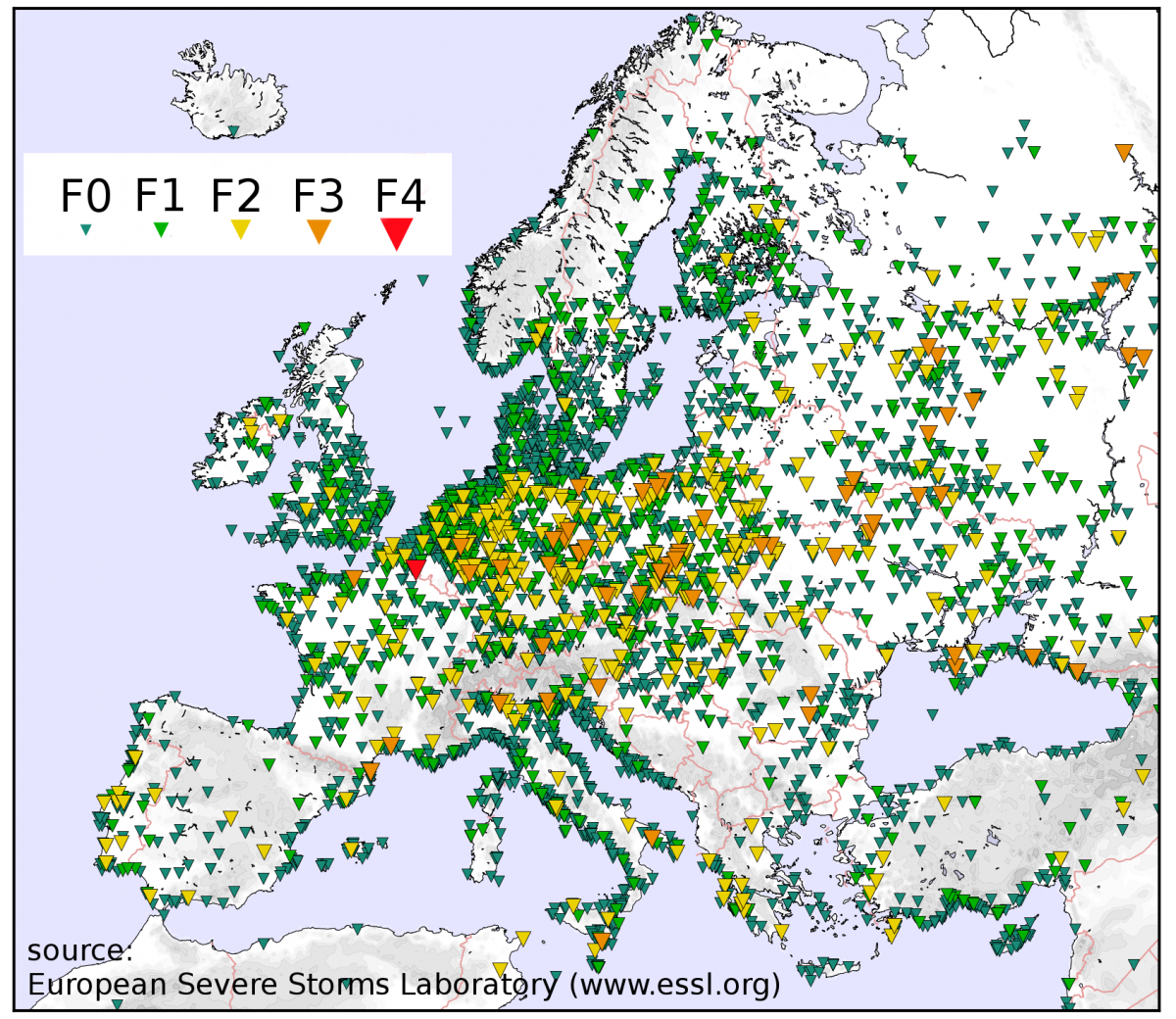
Bangladesh
Bangladesh has a well-known and destructive tornado history, and currently sits at number three as the country with the most reported tornadoes behind the U.S. and Canada. Not only is this country known for violent tornado outbreaks, it is also known for an incredibly high tornado fatality rate. In contrast to Canada, Bangladesh is one of the most populated countries in the world, putting many people in harm’s way of these destructive storms. Also, a country ridden by poverty, the majority of structures are not built to withstand tornadic winds. In fact, fatality rates of 30 or more per each tornado event are not uncommon even at present day.
The prevalence of tornadoes across Bangladesh all has to do with geography. South of the country is the large Bay of Bengal, which is a warm and humid body of water similar to the Gulf of Mexico (due to the influence of the Bay of Bengal, locals actually call the tornadoes “Bengal tornadoes.”). Take the warmth and moisture from the Sea of Bengal and couple that with the cold and dry air streaming south from the Himalayas and Tibetan Plateau to the north, and you’ve got the temperature/humidity clash needed to fuel tornadic storms. This clash is especially common during the Indian Monsoon season.
Unfortunately, Bangladesh also holds the record for single deadliest tornado. It occurred on April 26th, 1989 killing 1,300 people.
For more information on the tornado climatology for Bangladesh check out this site: http://bangladeshtornadoes.org/
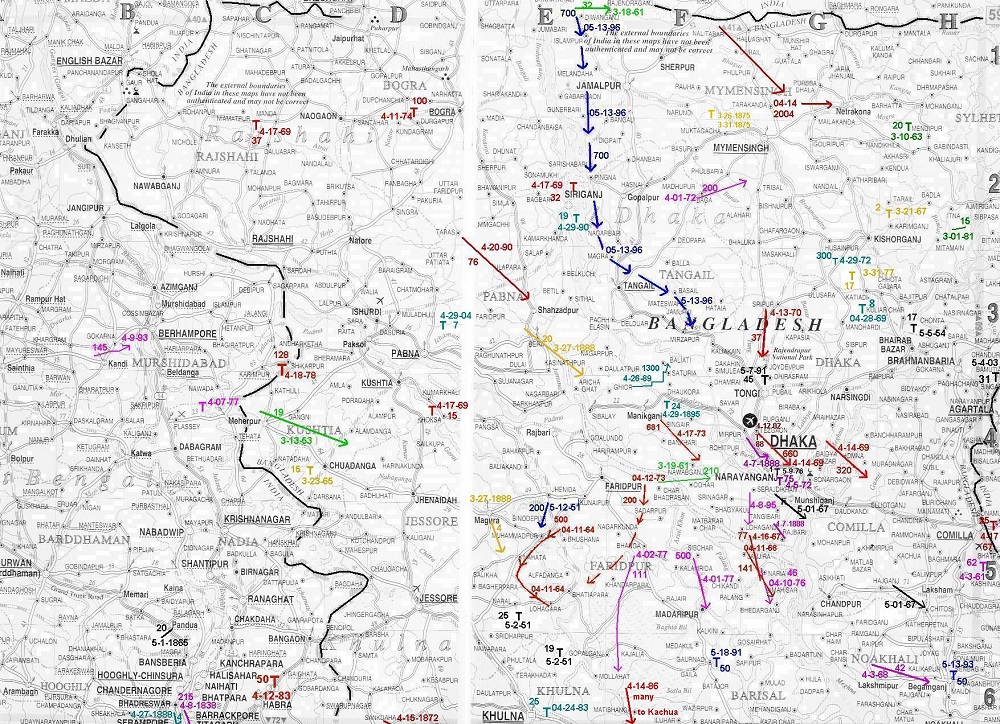
Australia
Researching Australian tornadoes, there were multiple articles stating that many people believe “tornadoes don’t happen in Australia.” While this is a myth, many meteorologists believe under-reporting due to desolate and low-populated areas is a major reason for the belief that tornadoes do not happen across Australia. On average, 20 to 25 tornadoes are reported in the country per year.
There is one major difference between Australian climatology when compared to the previously mentioned countries: Australia is not situated in the middle latitudes, meaning it does not experience a clash in different air masses and thus temperatures needed to frequently produce tornadic supercell thunderstorms. Instead, the vast majority of the tornadoes are caused by land-falling tropical cyclones, especially in the southeastern part of the country. New Zealand also sees a number of tornadoes each year.
Argentina
Argentina does not necessarily have a high annual average of tornadoes, but it does have a history of experiencing the strongest tornadoes in the southern hemisphere, and density of tornado reports is considerable. When all Argentinian recorded tornadoes are taken into account, the ratio of strong tornadoes (F/EF3-F/EF5 range) to weak tornadoes is higher than ratios elsewhere in the world (excluding the U.S.). In fact, the strongest tornado in the southern hemisphere on record occurred in the Sante Fe Province of Argentina (called the San Justo tornado) on January 10, 1973. This tornado had estimated winds equivalent to F5 intensity.
While there is not much other information readily available regarding tornado climatology for Argentina, it is believed that the Andes Mountains play an important role in influencing the air mass interactions and wind dynamics, priming an atmosphere conducive for tornado development.
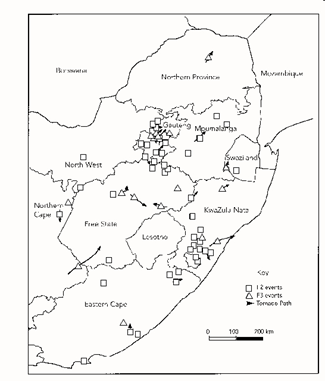
South Africa
The South African Weather Service reports that tornadoes occur all over the country, but surprisingly the highest concentration of confirmed tornadoes occurs in the mountainous region of the Free State of Gauteng. They report that 90 percent of their tornadoes are classified as F/EF 0-F/EF2, and most of the tornadoes occur during their spring and summer months, between October and February.
Conclusion
While the United States holds the gold medal when it comes to total number of tornadoes both on average annually and for overall total (recorded history), it is important to recognize that tornadoes do happen elsewhere around the world. The United States may have the most impressive climatology in terms of number, frequency, and intensity but other countries such as Bangladesh, Australia, and Argentina likewise boast impressive tornado histories.
Other countries not covered in detail, including Japan and China, are also home to at least a handful of tornadoes per year. In fact, even in places not highlighted on the world map, few are totally immune to their occurrence.
Bottom line: Not only is the Great Plains region the tornado alley of the United States, it’s the tornado alley of the world.
Ian Livingston contributed to this post.
References
List of Canadian tornadoes and tornado outbreaks
Environment Canada tornado information
British & European Tornado Extremes
List of North American tornadoes and tornado outbreaks
Information on Bangladesh tornado climatology
Rare, Powerful Tornado Hits Russian City
A review of worldwide tornadoes, A.M. Goligher and R.V. Milford
http://www.sciencedirect.com/science/article/pii/S0167610598000099
Latest posts by Kathryn Prociv (see all)
- Halloween tornadoes: The spooky historical facts - October 28, 2013
- From domestic to international: Tornadoes around the world - July 25, 2013
- U.S. tornadoes that occur outside the U.S. … the continental U.S. that is! - June 26, 2013
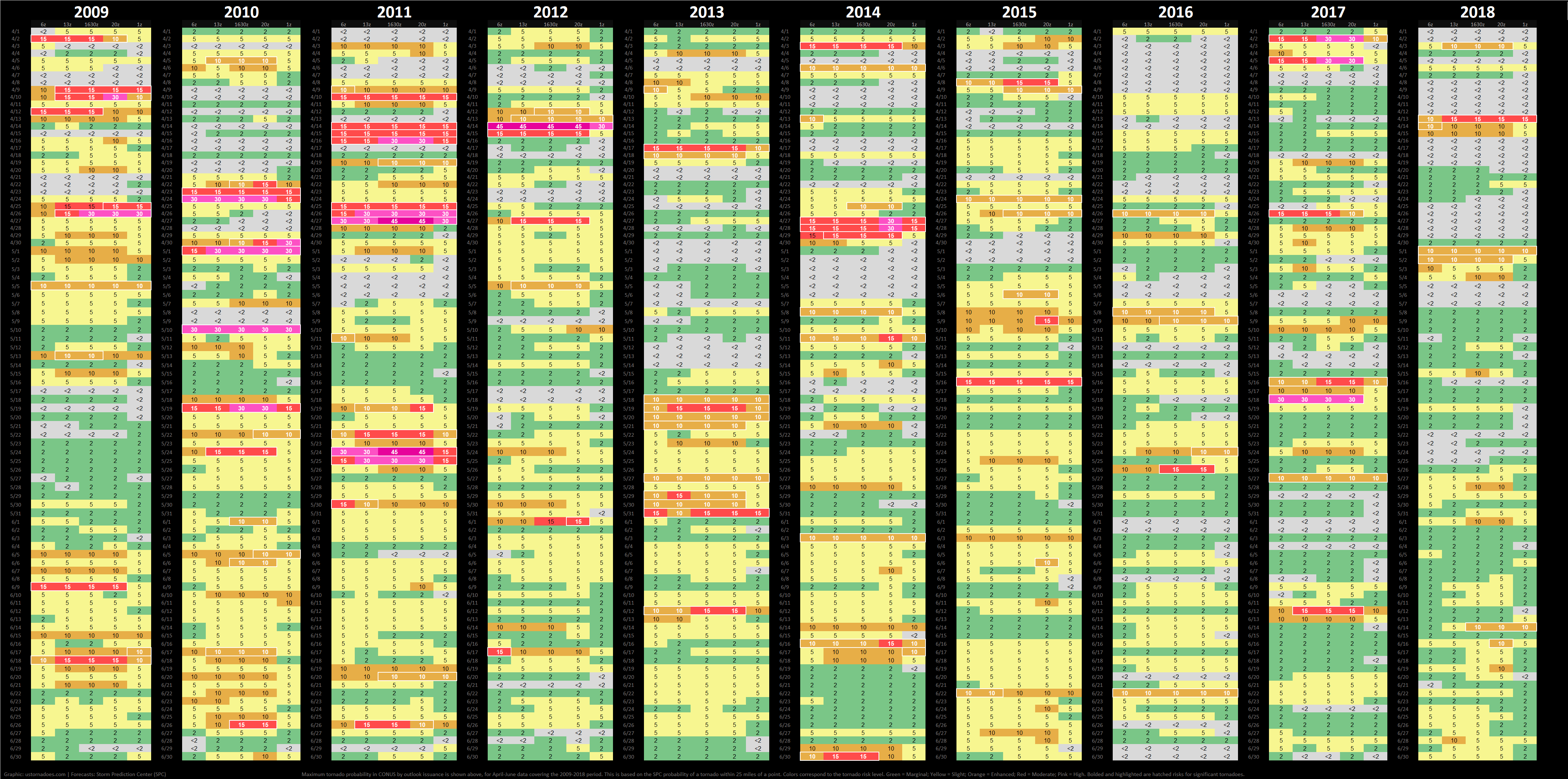
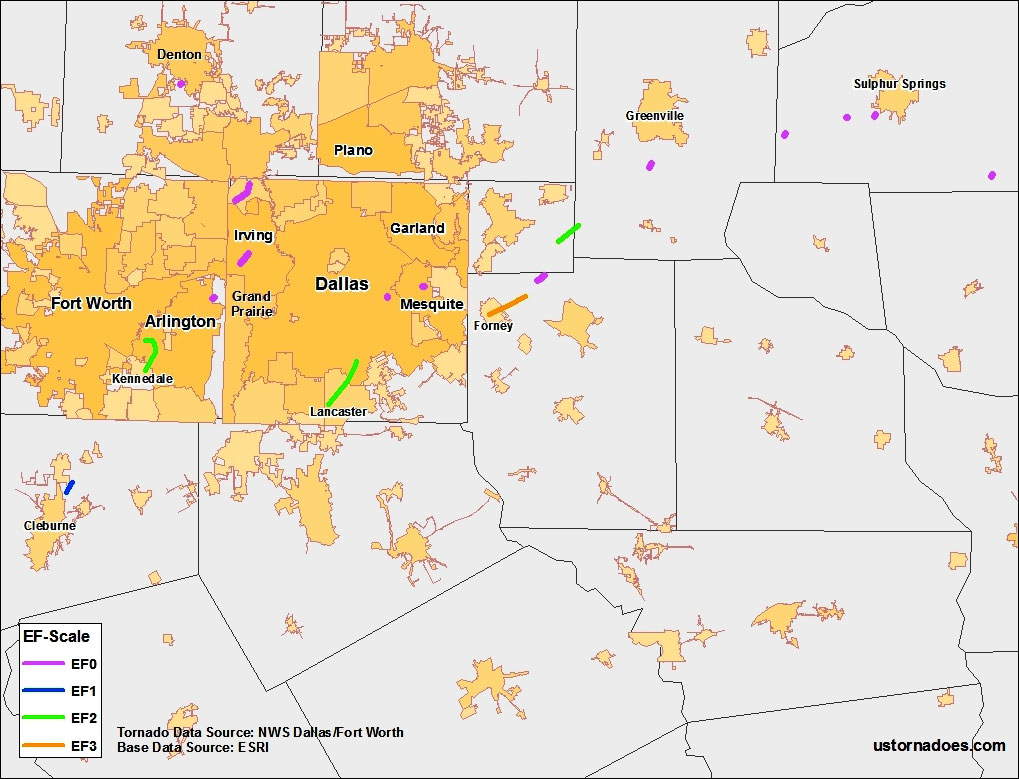
Very interesting, thanks Kathryn (and Ian) for a great overview of non-USA tornadoes. A few unexpected things come to mind when reading this:
-While the plains of interior Canada have an expected high number of tornadoes, I did not expect to see such density in Ontario and Quebec (thinking how adjacent NY, VT, NH, ME don’t have much relative activity).
-Very surprised Mexico doesn’t have more, especially immediately south of Texas, and also the central coasts due to the warm tropical air at the coast and dry cool mountain air in the interior (similar to Bangledesh) even at such low lattitudes the mechanics seem like they may be there but apprantly not. (Also, not sure how sophisticated the Mexican Met. Agency is compared to Canada or Europe on tracking them, could have something to do with it).
-Northern Ireland having a significant cluster…when I’ve been there in summer the weather lives up to its reputation as cool, grey, overcast, and drizzle. Not the conditions I would expect to form tornadoes.
Overall great article!
One thing on the Canada map is it covers 200+ years compared to the US record usually referenced since 1950. I do not believe the Canada database is publicly available so hard to say how many of those dots are pre 1950 in Canada. My guess is that’s at least part of it.
My guess on Ireland is many are cold core tornadoes like you see in California during winter with those big upper lows.
I would also assume that tornadoes are likely undercounted overall outside the US (they are probably even in the US to some degree still). Kathryn might have more info on Mexico.. I was a little surprised myself given its size if nothing else, tho even in South Texas there is a pretty marked dropoff in tornado activity compared to further north.
Very informative article! Although the most active areas for tornadoes in Canada have historically been in the prairie provinces and southern portions of Ontario, tornadoes are not rare occurances in western parts of Ontario, north & north-east of Lake Superior, east of Lake Huron & Georgian Bay, the Ottawa Valley, plus southern & central Quebec. In fact, significant and/or killer tornadoes have occured in each of these areas.
When one looks at the areas I just mentioned, one is struck by their immense size. Furthermore, all of these areas have a very low population density, except for southern portions of Ontario and Quebec. lf one considers these two factors, and take note of just how difficult it would be to spot a funnel cloud and confirm circulation on the ground when much in the huge regions that are dominated by forests and/or hilly terrain, it is obvious that a great many tornadoes may never be seen and reported in Canada.
Despite the fact that there is some radar coverage in the more populated areas, along with satellite remote sensing for identifying damage paths, I would suggest that the percentage of tornadoes that are never seen or remain unconfirned must be rather significant, especially in the years before radar/satellite technology. So, IMHO, the historicalrecords represent a huge under-representation of the true frequency of tornado events.
Thanks for your comments Jim and Derek! All great points, and ones that I agree with. I strongly believe that worldwide tornadoes are likely under-reported as mentioned, either due to poor reporting or simply prevalence over large and unpopulated areas.
Let’s face it the, United States has the best reporting of tornadoes than any other country and for two reasons: 1) our sophisticated technology, and 2) the white elephant in the room: the rising popularity of storm chasing!
with so many news about tornadoes in the course of this year is good to find this article in order to know which are the areas most prone to these disasters and to take preventive measures
Testing Twitter login. Tornadoes are cool!
Thank you for the informative article. I’ve always suspected that there must be wide occurrence of tornadoes outside the regions of North America that they are most commonly associated with. It’s important to note, as I think this article does, the important difference between frequency of tornado occurrence and frequency of tornado reporting. I was unaware of the importance of air mass interaction, as you detail it, in creating the conditions for tornadoes. From news coverage, I always associated tornadoes with the flat openness of North America’s central plains (which run from the Gulf of Mexico to the Arctic Ocean), not as much with the air masses originating from those bodies of water. I’ve always expected that there must be even more tornado activity in Central Eurasia than Central North America, but perhaps the east-west mountain chains (Alps, Caucasus, Hindu Kush, Pamirs, and Himalayas) interfere with the kind of air mass interaction that you describe. I would find further information on this most interesting. Also, I would like to know whether, in the age of satellite and radar technologies, if accurate reporting of tornado occurrence even away from human habitation is more possible and, if so, if accurate worldwide data is now being recorded.
Great article, and the maps of tornadoes elsewhere are superb.
All I can add is that the “flat and open terrain prone to clashes of Gulf of Mexico air and colder arctic air” are just part of the story leading to tornadoes. Another critical factor is the dry line, which causes the capping inversion and wind shear so often seen in soundings taken on strong tornado days. Geographically, that means a desert source of dry air to the west of the humid air coming from the tropical ocean source. The alignment of the US deserts and the Gulf of Mexico are perfect for this; the next best (worst?) in the world is Bangladesh. There’s lots more about this at the http://bangladeshtornadoes.org/bangladeshtornadoes1.html you referenced.
Thanks, Kathryn, for a great story, and I’m bookmarking it.
Your article didn’t include China which also experiences any number of them, particularly in Jiangxi Province.